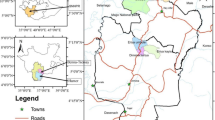Abstract
A survey of an upland village in the Philippines was conducted to assess local knowledge (LK) on tree utilization and conservation through personal interview of 40 local residents. The survey data were analyzed using descriptive statistics and simple preferential ranking. Respondents identified and classified 66 tree species according to their uses. Yakal, tugas, toog, narra and lauan were among the highly durable timber species identified. Several species for fuelwood, boat keel, furniture, post and fence, shade trees, food sources and medicine were also identified. In view of their utility, local people are inclined to conserve these species. However, illegal logging and kaingin farming are still threats to conservation and sustainable utilization of trees in the area.
Similar content being viewed by others
Notes
Premium species is a classification used by the Philippine Department of Environment and Natural Resources (DENR) for indigenous species warranting special protection.
References
Campilan D, Vega B (1998) Managing knowledge diversity for biodiversity: towards a new mainstream in research and development. In: Lawrence A, Mangaoang E (eds) Proceedings of the National Workshop on Local Knowledge and Biodiversity Conservation in Forestry Practice and Education, Visayas State University, Visca, Baybay, Leyte, Philippines, 19–23 Oct 1998
Clay JW, Alcorn J, Butler J (2000) Indigenous peoples, forestry management and biodiversity conservation: an analytical study for the world bank’s forestry policy implementation review and strategy development framework. World Bank, Washington DC
Cunningham WP, Cunningham MA, Saigo BW (2000) Environmental science: a global concern, 9th edn. McGraw Hill, Boston
Freeman J (1998) Biodiversity: use it or lose it! In: Lawrence A, Mangaoang E (eds) Proceedings of the national workshop on local knowledge and biodiversity conservation in forestry practice and education, Visayas State University, Visca, Baybay, Leyte, Philippines, 19–23 Oct 1998
Gray A (1995) The impact of biodiversity conservation on indigenous peoples. In: Biodiversity: social and ecological perspectives. World Rainforest Movement. Second impression. ZED Books. Penang, Malaysia
Ganapin DJ Jr (1998) Local knowledge and biodiversity conservation in forestry practice and education. In: Lawrence A, Mangaoang E (eds) Proceedings of national workshop on local knowledge and biodiversity conservation in forestry practice and education, Visayas State University, Visca, Baybay, Leyte, Philippines, 19–23 Oct 1998
Koku JE (2005) Tree planting, local knowledge and species preference in the South Tongu District of Ghana: some perspectives. GeoJournal, Kluwer Academic Publishers. www.cababstractplus.org/abstracts/Abstract.aspx?AcNo=200. Accessed June 1, 2009
Lean G, Hinrichsen D, Markham A (1990) WWF atlas of the environment. Prentice Hall, New York
MCNeely J, Miller K, Reid W, Mittermeir R, Werner T (1990) Conserving the world’s biological diversity. IUCN, WRI, CI, WWF-US and World Bank, Washington, DC
Nebel BJ, Wright RT (2000) Environmental science: the way the world works, 7th edn. Prentice-Hall Inc, Upper Saddle River, New Jersey
Poffenberger M (2000) Communities and forest management in South Asia. Working group on community involvement in forest management. Regional profile series. The world conservation union, Washington DC
Seeland K (2003) Indigenous knowledge of trees and forests in Orissa, India. Paper submitted to the XII World Forestry Congress 2003. Quebec City, Canada. www.fao.org/DOCREP/ARTICLE/WFC/XII/0327-A3.HTM. Accessed June 1, 2009
Sinclair FL, Joshi L (undated) Taking local knowledge about trees seriously. ETFRN Publication Series. www.etfrn.org/ETFRN/workshop/users/chapter-3pdf. Accessed June 1, 2009
Vergara NT (1998) Indigenous knowledge and biodiversity conservation in forestry. In: Lawrence A, Mangaoang E (eds) Proceedings of national workshop on local knowledge and biodiversity conservation in forestry practice and education, Visayas State University, Visca, Baybay, Leyte, Philippines, 19–23 Oct 1998
World Commission on Environment and Development (1987) Our common future. Chapter 4 Section 74 (Population and Human Resources). http:/www.un-documents.ned/wced-ocf.htm. Accessed 1 June 2009
World Resources Institute (WRI), International Union Conservation Network (IUCN), United Nations Environment Program (UNEP) (1992) Global biodiversity strategy: guidelines for actions to save, study, and use earth’s biotic wealth sustainably and equitably. WRI, IUCN and UNEP, Washington DC
World Wide Fund for Nature (WWF) (2005) Species lost and existing. www.panda.org. Accessed 4 Dec 2007
Acknowledgment
We are indebted to the local people of Butigan for their help and to Forester Anatolio Polinar of the Visayas State University for the scientific names of plant species.
Author information
Authors and Affiliations
Corresponding author
Rights and permissions
About this article
Cite this article
Goliat, J., Pasa, A. Local Knowledge on Tree Utilization and Conservation: The Case in Butigan, Baybay, Leyte, Philippines. Small-scale Forestry 8, 399–410 (2009). https://doi.org/10.1007/s11842-009-9091-5
Received:
Accepted:
Published:
Issue Date:
DOI: https://doi.org/10.1007/s11842-009-9091-5




